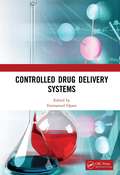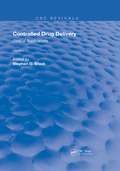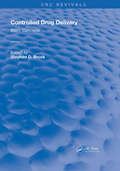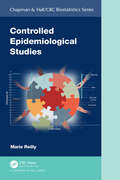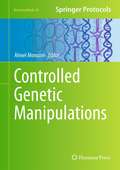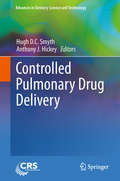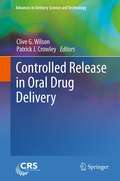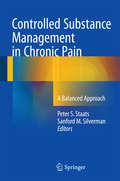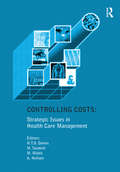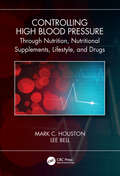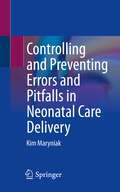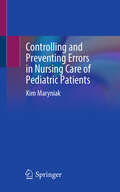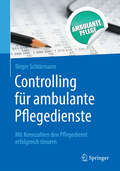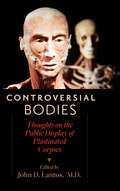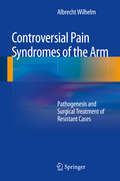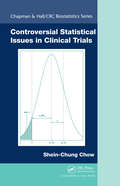- Table View
- List View
Control: The Dark History and Troubling Present of Eugenics
by Adam RutherfordThroughout history, people have sought to improve society by reducing suffering, eliminating disease or enhancing desirable qualities in their children. But this wish goes hand in hand with the desire to impose control over who can marry, who can procreate and who is permitted to live. In the Victorian era, in the shadow of Darwin's ideas about evolution, a new full-blooded attempt to impose control over our unruly biology began to grow in the clubs, salons and offices of the powerful. It was enshrined in a political movement that bastardised science, and for sixty years enjoyed bipartisan and huge popular support. Eugenics was vigorously embraced in dozens of countries. It was also a cornerstone of Nazi ideology, and forged a path that led directly to the gates of Auschwitz. But the underlying ideas are not merely historical. The legacy of eugenics persists in our language and literature, from the words 'moron' and 'imbecile' to the themes of some of our greatest works of culture. Today, with new gene editing techniques, very real conversations are happening - including in the heart of British government - about tinkering with the DNA of our unborn children, to make them smarter, fitter, stronger. CONTROL tells the story of attempts by the powerful throughout history to dictate reproduction and regulate the interface of breeding and society. It is an urgently needed examination that unpicks one of the defining and most destructive ideas of the twentieth century. To know this history is to inoculate ourselves against its being repeated.
Controlled Drug Delivery Systems
by Emmanuel OparaThis book will describe current research on drug delivery systems that encompass four broad categories, namely: routes of delivery, delivery vehicles, payload, and targeting strategies. Where appropriate delivery vehicles and relevant release of specific agents in any of these categories in clinical application will be discussed. All chapters will highlight the translational aspects of the various technologies discussed and will provide insights into the advantages of such delivery systems over current ones in clinical or research use. Each technology reviewed in this book will have significant potential to improve patients' lives by enhancing the therapeutic efficacy of drugs. This book: Discusses the various factors that mitigate effective oral insulin delivery and the current status of research efforts to overcome these barriers along with recent clinical projections Examines the advantages and disadvantages of each drug delivery system Examines the standard method of accomplishing controlled drug release through the incorporation of the drugs within polymeric biomaterials such as capsules and microcapsules as well as other vehicles such as liposomes Discusses various controlled drug delivery systems, including sustained release delivery systems and pulse or delayed release, e.g. to target different regions of the gastrointestinal tract. In view of these wide-ranging technological areas, and the up-to-date discussions of opportunities and challenges associated with these applications, the book should provide readers from technology, materials science, pharmacology and clinical disciplines with very valuable information.
Controlled Drug Delivery Systems: Towards New Frontiers in Patient Care (SpringerBriefs in Applied Sciences and Technology)
by Filippo Rossi Giuseppe Perale Maurizio MasiThis book offers a state-of-the-art overview of controlled drug delivery systems, covering the most important innovative applications. The principles of controlled drug release and the mechanisms involved in controlled release are clearly explained. The various existing polymeric drug delivery systems are reviewed, and new frontiers in material design are examined in detail, covering a wide range of polymer modification techniques. The concluding chapter is a case study focusing on use of a drug-eluting stent. The book is designed to provide the reader with a complete understanding of the mechanisms and design of controlled drug delivery systems, and to this end includes numerous step-by-step tutorials. It illustrates how chemical engineers can advance medical care by designing polymeric delivery systems that achieve either temporal or spatial control of drug delivery and thus ensure more effective therapy that eliminates the potential for both under-and overdosing.
Controlled Drug Delivery: Volume 1 Basic Concepts (Routledge Revivals)
by Stephen D. BruckPublished in 1983: Volume 1 deals with basic pharmacological aspects of controlled drug delivery, transport of small molecules through polymers, biodegradation of polymers with or without enzymatic involvement, and drug carriers.
Controlled Drug Delivery: Volume 2 Clinical Applications (Routledge Revivals)
by Stephen D. BruckPublished in 1983: Volume 2 deals with critical analyses of various test methodologies of polymeric implants, including their acute and chronic toxicological evaluation.
Controlled Drug Release Of Oral Dosage Forms
by Jean-Maurice VergnaudNumerical analysis of matter transfer is an area that pharmacists find difficult, but which is a technique frequently used in preparing controlled drug release and oral dosage forms. A practical guide which explains how to carry out the numerical analysis of matter transfer - a vital process when examining the formulation of oral dosage forms with controlled drug release. The author models the process of drug delivery using numerical analysis and computerization.
Controlled Epidemiological Studies (Chapman & Hall/CRC Biostatistics Series)
by Marie ReillyThis book covers classic epidemiological designs that use a reference/control group, including case-control, case-cohort, nested case-control and variations of these designs, such as stratified and two-stage designs. It presents a unified view of these sampling designs as representations of an underlying cohort or target population of interest. This enables various extended designs to be introduced and analysed with a similar approach: extreme sampling on the outcome (extreme case-control design) or on the exposure (exposure-enriched, exposure-density, countermatched), designs that re-use prior controls and augmentation sampling designs. Further extensions exploit aggregate data for efficient cluster sampling, accommodate time-varying exposures and combine matched and unmatched controls. Self-controlled designs, including case-crossover, self-controlled case series and exposure-crossover, are also presented. The test-negative design for vaccine studies and the use of negative controls for bias assessment are introduced and discussed. This book is intended for graduate students in biostatistics, epidemiology and related disciplines, or for health researchers and data analysts interested in extending their knowledge of study design and data analysis skills. This book Bridges the gap between epidemiology and the more mathematically oriented biostatistics books. Assembles the wealth of epidemiological knowledge about observational study designs that is scattered over several decades of scientific publications. Illustrates the performance of methods in real research applications. Provides guidelines for implementation in standard software packages (Stata, R). Includes numerous exercises, covering simple mathematical proofs, consideration of proposed or published designs, and practical data analysis.
Controlled Genetic Manipulations (Neuromethods #65)
by Alexei MorozovThe current demand for the development of techniques for controlled genetic manipulations is driven by the anatomical and physiological complexity of the brain and by the need for experimental models that can address this complexity through selective manipulation of defined components of the system: specific neuronal populations or selected synapses. In Controlled Genetic Manipulations, expert researchers present detailed chapters to supply basic technical information about controlled genetic manipulations and to provide examples of creative implementation of this methodology when addressing a unique biological problem. Some chapters of the book describe the most recent developments in the basic methodology, which includes use of Cre-recombinase, methods for delivery of genetic material into the brain and the use of optogenetics, whereas other chapters focus on applying these techniques to addressing particular biological questions like structural and functional mapping of neuronal circuits, analysis of specific synaptic connections, modeling or gene therapy of neurological disorders. As part of the Neuromethods series, chapters include key implementation advice that is crucial for getting optimal results. Authoritative and practical, Controlled Genetic Manipulations serves as a valuable guide to a variety of techniques, provided by many of the pioneers of the approaches.
Controlled Pulmonary Drug Delivery: Controlled Pulmonary Drug Delivery (Advances in Delivery Science and Technology)
by Anthony J. Hickey Hugh D.C. SmythThe pace of new research and level of innovation repeatedly introduced into the field of drug delivery to the lung is surprising given its state of maturity since the introduction of the pressurized metered dose inhaler over a half a century ago. It is clear that our understanding of pulmonary drug delivery has now evolved to the point that inhalation aerosols can be controlled both spatially and temporally to optimize their biological effects. These abilities include controlling lung deposition, by adopting formulation strategies or device technologies, and controlling drug uptake and release through sophisticated particle technologies. The large number of contributions to the scientific literature and variety of excellent texts published in recent years is evidence for the continued interest in pulmonary drug delivery research. This reference text endeavors to bring together the fundamental theory and practice of controlled drug delivery to the airways that is unavailable elsewhere. Collating and synthesizing the material in this rapidly evolving field presented a challenge and ultimately a sense of achievement that is hopefully reflected in the content of the volume.
Controlled Release in Oral Drug Delivery (Advances in Delivery Science and Technology)
by Clive G. Wilson Patrick J. CrowleyControlled Release in Oral Drug Delivery provides focus on specific topics, complementing other books in the initial CRS series. Each chapter sets the context for the inventions described and describe the latitude that the inventions allow. In order to provide some similar look to each chapter, the coverage includes the historical overview, candidate drugs, factors influencing design and development, formulation and manufacturing and delivery system design. This volume was written along three main sections: the relevant anatomy and physiology, a discussion on candidates for oral drug delivery and the major three groups of controlled release systems: diffusion control (swelling and inert matrices); environmental control (pH sensitive coatings, time control, enzymatic control, pressure control) and finally lipidic systems.
Controlled Substance Management in Chronic Pain: A Balanced Approach
by Peter S. Staats Sanford M. SilvermanThis comprehensive guide covers prescribing controlledsubstances for patients with acute or chronic pain and provides a balanceddiscussion on appropriate treatment, addiction, safety and complications. Chapters feature evidence-based strategies and clinical modalities that addressdiagnostic challenges, treatment guidance, alternatives to opioid managementand the significant legal risks within the current regulatoryenvironment. Authored by leaders in pain medicine, physicians andappropriate health care professionals will find Controlled SubstanceManagement in Chronic Pain to be an indispensable resource.
Controlling & Innovation 2022: Gesundheitswesen (FOM-Edition)
by Thomas Kümpel Thomas Heupel Kay SchlenkrichDieses Buch greift die derzeitigen besonderen Herausforderungen des Gesundheitswesens auf und diskutiert diese sowohl aus wissenschaftlicher als auch aus praxisnaher Perspektive. Die vielfältigen neuen medizinischen sowie technologischen Möglichkeiten erfordern erhebliche finanzielle Ressourcen. Dabei müssen die Akteurinnen und Akteure im Gesundheitswesen drei übergeordnete Zielkategorien beachten, die häufig miteinander konkurrieren: Dies ist erstens die Erbringung medizinischer Leistung nach aktuellem wissenschaftlichen Stand, zweitens die Einhaltung von ökonomischen Zielkriterien sowie schließlich die Abwägung zwischen gesellschaftlicher Wertorientierung und Patientenwünschen.Die zunehmende Komplexität dieses Zielsystems hat zur Folge, dass die wesentlichen Erbringer medizinischer Leistungen zu einem neuen, umfassenderen Controlling-Verständnis kommen müssen, um diese Vielschichtigkeit steuer- und handhabbar zu machen. Dieses Buch richtet sich daher an alle im Gesundheitswesen beschäftigten Mitarbeitenden, an Studierende und Forschende in diesem Sektor sowie an alle interessierten Leserinnen und Leser. Ein besonderer Schwerpunkt liegt auf Aspekten des Controllings des Leistungsprozesses in Krankenhäusern sowie der besseren Gesundheitsförderung durch die Möglichkeiten der Digitalisierung.
Controlling Contagion: Epidemics and Institutions from the Black Death to Covid (The Princeton Economic History of the Western World)
by Sheilagh OgilvieHow human institutions—markets, states, communities, religions, guilds and families—have helped both to control and to exacerbate epidemics throughout history.How do societies tackle epidemic disease? In Controlling Contagion, Sheilagh Ogilvie answers this question by exploring seven centuries of pandemics, from the Black Death to Covid-19. For most of history, infectious diseases have killed many more people than famine or war, and in 2019 they still caused one death in four. Today, we deal with epidemics more successfully than our ancestors managed plague, smallpox, cholera or influenza. But we use many of the same approaches. Long before scientific medicine, human societies coordinated and innovated in response to biological shocks—sometimes well, sometimes badly.Ogilvie uses historical epidemics to analyse how human societies deal with &“externalities&”—situations where my action creates costs or benefits for others beyond those that I myself incur. Social institutions—markets, states, communities, religions, guilds, and families—help us manage the negative externalities of contagion and the positive externalities of social distancing, sanitation, and immunization. Ogilvie shows how each institution enables us to coordinate, innovate and inspire each other to limit contagion. But each institution also has weaknesses that can make things worse. Markets shut down voluntarily during every epidemic in history—but they also brought people together, spreading contagion. States mandated quarantines, sanitation, and immunization—but they also waged war and censored information, exacerbating epidemics. Religions admonished us to avoid infecting our neighbours—but they also preached against science and medical innovations. What decided the outcome, Ogilvie argues, was a temperate state, an adaptable market, and a strong civil society where a diversity of institutions played to their own strengths and checked each other&’s flaws.
Controlling Costs: Strategic Issues in Health Care Management
by Huw T.O. Davies Manouche TavakoliControlling costs in health care is rarely something that can be tackled in isolation. Cost control invariably interacts with issues of quality and health care access. Thus, this diverse collection of papers is concerned not just with costs but more importantly with value. Both macro and micro concerns are covered. At the macro level, health care reforms (and especially the ’marketisation’ of health care systems) receive some attention. Papers explore how policy prescriptions get translated and modified during implementation, and assess how these prescriptions impact on both the incentive context and subsequent patterns of service delivery. Resource allocation within bureaucratic health systems continues to pose problems and these too are analysed with new solutions being proposed. At the micro level, a number of contributors wrestle with the difficulties of carrying out the economic evaluation of new drugs and technologies. In each case, the wider theoretical and practical implications of balancing costs and benefits are explored. This collection should prove helpful to health care policy specialists, managers and researchers interested in gaining a feel for the real-world application of cost-focused health services research.
Controlling High Blood Pressure through Nutrition, Supplements, Lifestyle and Drugs
by Mark C. Houston Lee BellControlling High Blood Pressure through Nutrition, Nutritional Supplements, Lifestyle, and Drugs helps prevent and treat high blood pressure and hypertension, the most common primary diagnosis in the United States and a leading cause of heart attack, heart failure, kidney failure, and stroke. Written by two leading experts in nutrition and hypertension, it takes an integrative and evidence-based approach based on scientific research and clinical studies. It explains what causes high blood pressure and includes easy-to-follow solutions for patients that help to treat and prevent it. These include: The ideal drugs to reduce blood pressure with fewest side effects and optimal efficacy A nutrition program to reduce weight and lower the risk of a cardiovascular problem A comprehensive review of nutritional supplements to improve blood pressure control and reduce cardiovascular disease A review of lifestyle changes to improve blood pressure such as a detailed exercise program. This book is for doctors, nutritionists, naturopaths, pharmacists and other health practitioners as well as anyone with a family history of hypertension or overt blood pressure issues that would like to make better and healthier lifestyle choices.
Controlling and Preventing Errors and Pitfalls in Neonatal Care Delivery
by Kim MaryniakThe aim of this book is to inform nurses about the most common and the more serious errors made in caring for neonatal patients. Nurses play the largest role in patient care and their overwhelming workload may sometimes lead to errors that are, in some cases, irreversible or even fatal, putting a great deal of responsibility on nurses to avoid errors. And amongst patients that nurses care for, the most vulnerable of these are neonates. This book covers learnings about the uniqueness of neonatal patients and common conditions that are seen with patients in the neonatal intensive care unit (NICU). Factors that are predisposing and contributing factors for nursing errors are reviewed. The types of errors, consequences, detection, and monitoring for nursing errors are included. The book describes how errors can be avoided with necessary precautions, and managed appropriately based on current evidence-based practice. Recommendations for further study are also provided. This resource can be a useful tool for professional nurses, as well as nurse educators, leaders, and mentors to educate and guide their students and novice nurses.
Controlling and Preventing Errors in Nursing Care of Pediatric Patients
by Kim MaryniakThis book offers nurses guidance about the most common and the more serious errors made in caring for pediatric patients, from infants to adolescents (ages 0-18 years), and how they can be avoided. Nurses play the largest role in patient care, and their overwhelming workload may sometimes lead to errors that are, in some cases, irreversible, putting a great deal of responsibility on nurses. This book is unique in identifying risk, potential, and actual errors, determining root causes, and identifying best practices.This book covers learning specific to pediatric patients, such as their frailty or their inability to communicate. It also reviews the predisposing and contributing factors (staff shortage, work overload, fatigue) and describes the types of errors, including omission, medication errors (prescribing, dosing), identification errors, and procedural errors to name a few. Consequences, detection, and monitoring for nursing errors are also included.The book describeshow errors can be avoided by taking the appropriate measures and how they can be adequately managed according to current evidence-based practice. Recommendations for further study are also provided.This is a valuable resource for professional nurses, as well as nurse educators, leaders, and mentors to train and guide their students and novice nurses.
Controlling für ambulante Pflegedienste
by Birger SchlürmannKennzahlen: Was ist darunter zu verstehen? Weshalb benötige ich sie für meinen Pflegedienst? Wie kann ich sie sinnvoll nutzen, um mein Unternehmen effektiv zu steuern? Das und vieles mehr sind Fragen, die der Autor in diesem Buch beantwortet. Praxisnah werden die Grundlagen des Controllings erklärt und ein Kennzahlensystem beschrieben, das Sie für Ihren ambulanten Pflegedienst nutzen können. Sie erfahren, wie betriebliche Entwicklungen detailliert abgebildet werden und somit zeitnah Veränderungen erkannt und auf diese gezielt reagiert werden kann. Viele Best-Practice-Beispiele garantieren einen hohen Praxisbezug.
Controlling im Betrieblichen Gesundheitsmanagement: Das 7-Schritte-Modell
by Holger Pfaff Sabrina ZeikeDas Betriebliche Gesundheitsmanagement wird zunehmend komplexer und damit schwieriger zu steuern. Dieses Buch unterstützt die Verantwortlichen bei der professionellen Bewältigung dieser Steuerungsaufgabe. Es führt in das umfangreiche Thema des Controllings im Betrieblichen Gesundheitsmanagement ein, erläutert die Grundbegriffe und liefert einen Orientierungsrahmen für die professionelle Planung wirkungsvoller Gesundheitsmaßnahmen. Im Mittelpunkt steht das 7-Schritte-Modell des Controllings – ein Tool zur Strukturierung von Kennzahlen für einen zielgerichteten und wirksamen Einsatz, das sich flexibel an die Unternehmensstrategie anpasst und den Anforderungen an ein modernes und agiles Controlling gerecht wird. Ein Muss zum Aufbau und zur Erhaltung eines nachhaltigen Betrieblichen Gesundheitsmanagements!
Controlling im Gesundheitswesen: Transparenz für Entscheidungen mit Fällen aus der Praxis
by Dagmar AckermannDieses Buch präsentiert eine Vielfalt aus der Realität abgeleiteter Situationen sowohl aus Krankenhäusern und Pflegeeinrichtungen als auch bei niedergelassenen Ärzten, in Apotheken und Krankenversicherungen. Vor dem Hintergrund der Finanzierung von Gesundheitsleistungen spiegeln die Fallbeispiele typische Herausforderungen wider, mit denen sich die jeweiligen Akteure auseinandersetzten müssen. Die Bandbreite der Themen reicht von operativen bis hin zu strategischen Controlling-Aufgaben. Das Werk geht dabei auf die Herausforderungen für das Leistungs-, Qualitäts-, Personal- und Finanzcontrolling ein und thematisiert die Bedeutung des Investitionscontrollings. Ergänzt werden die Fallstudien durch Teaching Notes, die anzustrebende Lernziele formulieren. Hinzukommen strukturierte Fragen, die beim Selbststudium eine fundierte Bearbeitung der Fälle ermöglichen und es werden Hinweise zur Vertiefung der für die Fälle zentralen Themen gegeben. Im Anhang sind für jeden Fall Kennzahlen zu finden, die in der Praxis des Managements für Gesundheitseinrichtungen genutzt werden.
Controlling im Krankenhaus: Das Zusammenspiel von Werten, Prozessen und Innovationen (Controlling im Krankenhaus #6)
by Winfried ZappDieses Buch fromuliert und beleuchtet Werte aus der Sicht der Ökonomie und Anforderungen aus der Ethik als Ausgangsbasis für eine differenzierte Betrachtung von Controlling. Als ein wesentlicher Ansatz der letzten Jahre wird die Corporate Social Responsibility (CSR) konstruktiv-kritisch analysiert. Neben der Wertediskussion ist die Bedeutung der Prozesse für das Gesundheitswesen immer wieder hervorgehoben worden. In zwei Beiträgen wird dabei die Ergänzung um das Blueprinting und die Möglichkeiten des Lean Management herausgearbeitet. Soll eine Ausrichtung an Werten und eine verbesserte Struktierung von Prozessen gelingen, dann sind unabdingbar Innovationen zu gestalten und voranzutreiben. Dabei wird in diesem Buch ein Innovationscontrolling entwickelt, um diese Entwicklung zu begleiten und die Bedeutung von Verzerrungen hervorgehoben. Ausführungen zu einer Optimierung des Controlling unter Beachtung der Konzeption um ein Behavioral Accounting und zu einer fallmixorientierten Vorgehensweise schließen das Buch ab. Nur wenn Klarheit und Konsensus über die angestrebten Werte besteht, können Prozesse eingeleitet werden, um das Arbeitsziel otpimaler zu erreichen. Dazu bedarf nicht nur eingefahrener Wege und Überlegungen, sondern innovativer Gestaltungskraft. Das Buch möchte hierzu Wege aufzeigen.
Controls of Serm Motility: Biological and Clinical Aspects (Routledge Revivals)
by Claude GagnonFirst published in 1990, this timely book provides the first comprehensive state-of-the-art updates on various aspects of sperm motility. The first section describes in detail the structures, molecules and regulatory mechanisms involved in sperm movement. Also reported are the effects of external milieu and egg factors on the initiation and types of sperm motility. The second section covers how to measure sperm motility in human semen and in capacitating media. The book addresses the prognostic value of motility parameters in cases of infertility. It covers the clinical significance of various drugs and toxins on sperm motility and the clinical management of infertile males with sperm motility defects. This volume is indispensable to biochemists, cell biologists and andrologists interested in cell motility, and to urologists, obstetricians, gynecologists, and endocrinologists involved in the management of infertility. It is of value to those in reproduction, animal science, veterinary science, and vertebrate zoology. The book contains basic and clinically relevant information for graduate students, researchers and clinicians.
Controversial Bodies: Thoughts on the Public Display of Plastinated Corpses
by John D. LantosControversial, fascinating, disturbing, and often beautiful, plastinated human bodies—such as those found at Body Worlds exhibitions throughout the world—have gripped the public's imagination. These displays have been lauded as educational, sparked protests, and drawn millions of visitors. This book looks at the powerful sway these corpses hold over their living audiences everywhere.Plastination was invented in the 1970s by German anatomist Gunther von Hagens. The process transforms living tissues into moldable plastic that can then be hardened into a permanent shape. Von Hagens first exhibited his expertly dissected, artfully posed plastinated bodies in Japan in 1995. Since then, his shows have continuously attracted so many paying customers that they have inspired imitators, brought accusations of unethical or even illegal behavior, and ignited vigorous debates among scientists, educators, religious leaders, and law enforcement officials. These lively, thought-provoking, and sometimes personal essays reflect on such public displays from ethical, legal, cultural, religious, pedagogical, and aesthetic perspectives. They examine what lies behind the exhibitions' popularity and explore the ramifications of turning corpses into a spectacle of amusement. Contributions from bioethicists, historians, physicians, anatomists, theologians, and novelists dig deeply into issues that compel, upset, and unsettle us all.
Controversial Pain Syndromes of the Arm: Pathogenesis and Surgical Treatment of Resistant Cases
by Albrecht WilhelmThis concise, well-illustrated monograph explains the true pathogenesis, hitherto unsolved, of five key pain syndromes of the arm and describes diagnosis, indications for surgery, surgical techniques and results. The syndromes in question are tennis elbow, golf elbow, proximal radial nerve compression syndrome, so-called coracoiditis and Sudeck's dystrophy. In each case, the neurogenic pathogenesis is identified and deficiencies of other interpretations, for example that these conditions are the result of degenerative processes, are discussed. Appropriate surgical techniques in resistant cases are described in the context of pathogenesis and treatment outcomes are documented. The fact that these outcomes are excellent in the large majority of cases may be taken as support for the author's interpretation of pathogenesis. This book will be informative and instructive for all hand, orthopedic, trauma, plastic, general and neurosurgeons as well as neurologists and hand therapists.
Controversial Statistical Issues in Clinical Trials (Chapman & Hall/CRC Biostatistics Series)
by Shein-Chung ChowIn clinical trial practice, controversial statistical issues inevitably occur regardless of the compliance with good statistical practice and good clinical practice. But by identifying the causes of the issues and correcting them, the study objectives of clinical trials can be better achieved. Controversial Statistical Issues in Clinical Trials cov

